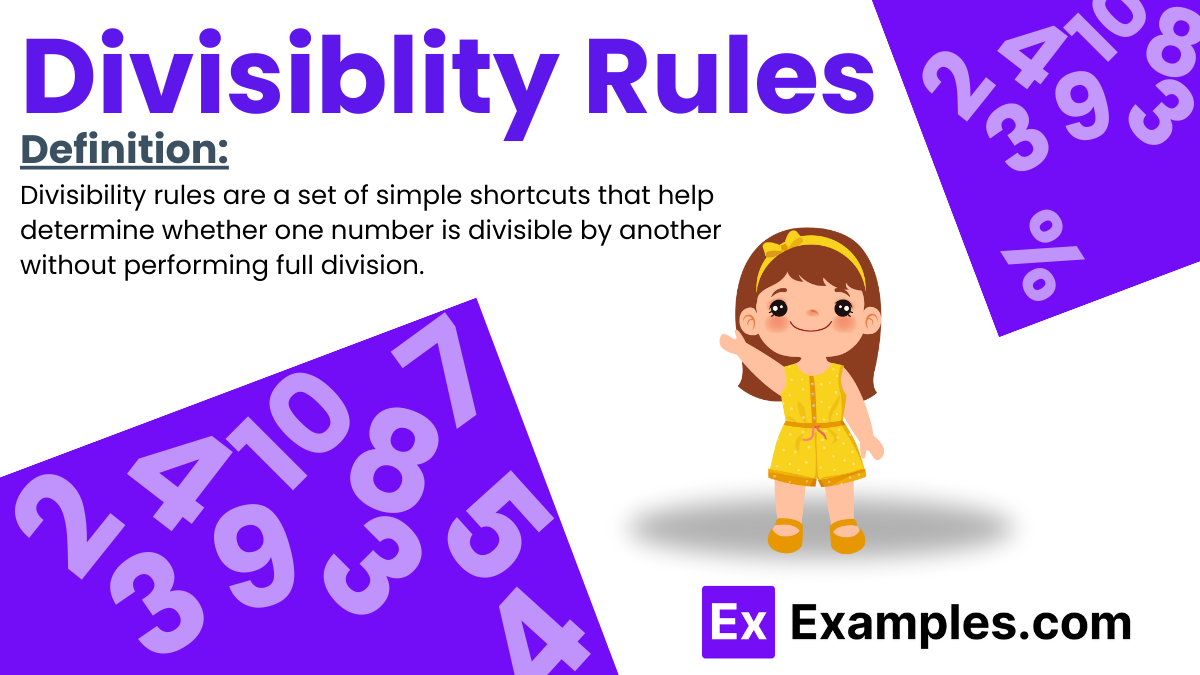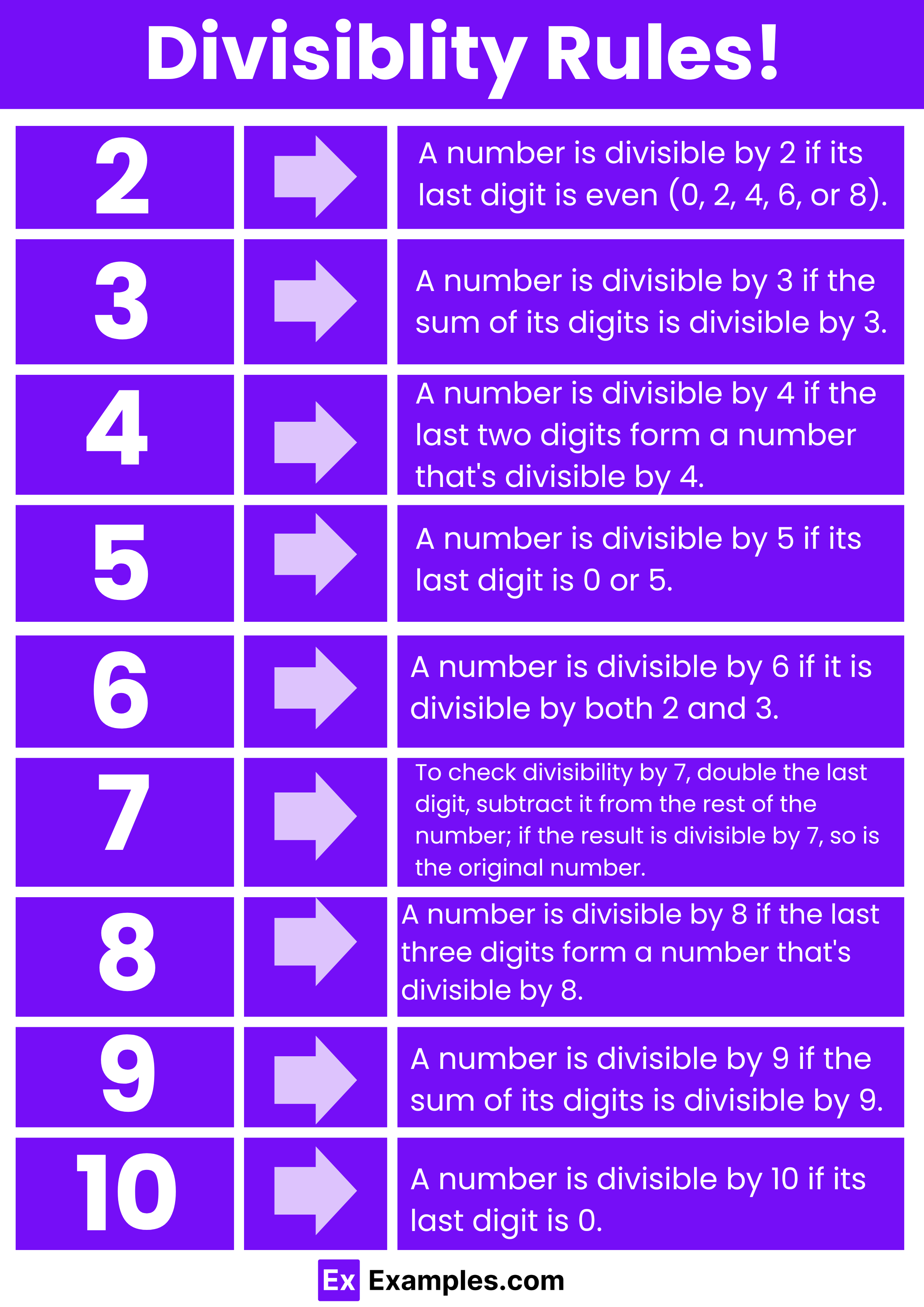Find the number divisible by 2
143
257
368
471


Divisibility rules are a set of simple shortcuts that help determine whether one number is divisible by another without performing full division. These rules make it easy to quickly identify factors of large numbers, which is particularly useful in simplifying fractions, finding greatest common divisors, and solving problems involving multiples.

| Divisor | Rule | Example |
|---|---|---|
| 2 | A number is divisible by 2 if its last digit is even (0, 2, 4, 6, or 8). | 136: Last digit is 6 (even), so 136 is divisible by 2. |
| 3 | A number is divisible by 3 if the sum of its digits is divisible by 3. | 111: Sum of digits = 1+1+1 = 3, which is divisible by 3. |
| 4 | A number is divisible by 4 if the last two digits form a number that’s divisible by 4. | 1224: Last two digits are 24, which is divisible by 4. |
| 5 | A number is divisible by 5 if its last digit is 0 or 5. | 145: Last digit is 5, so 145 is divisible by 5. |
| 6 | A number is divisible by 6 if it is divisible by both 2 and 3. | 132: Divisible by 2 (last digit 2 is even) and by 3 (sum of digits 1+3+2 = 6). |
| 7 | To check divisibility by 7, double the last digit, subtract it from the rest of the number; if the result is divisible by 7, so is the original number. | 343: 34 – 2*3 = 28, which is divisible by 7. |
| 8 | A number is divisible by 8 if the last three digits form a number that’s divisible by 8. | 1600: Last three digits are 600, which is divisible by 8. |
| 9 | A number is divisible by 9 if the sum of its digits is divisible by 9. | 2349: Sum of digits = 2+3+4+9 = 18, which is divisible by 9. |
| 10 | A number is divisible by 10 if its last digit is 0. | 230: Last digit is 0, so 230 is divisible by 10. |
Below is a list of 30 examples demonstrating the divisibility rules for various numbers. These examples are designed to help educators and students easily understand how to apply these rules in practice.
Mastering divisibility rules not only helps with simplifying mathematical operations but also enhances speed and accuracy in problem-solving. Here are some practical tips and tricks to effectively use divisibility rules:
Solution:
Given, 154 is a number.
If the last digit of 154 is divisible by 2, then 154 is also divisible by 2.
The last digit of 154 is 4, which is divisible by 2, such that;
4/2 = 2
Hence, 154 satisfies the divisibility rule for 2.
Solution:
As we can see, the last two digits of 629 are 29, which is not divisible by 4.
Hence, 629 is not divisible by 4.
Solution:
Given, 276 is a number.
A number is divisible by 3 if the sum of its digits is divisible by 3.
The sum of the digits in 276 is 2 + 7 + 6 = 15, which is divisible by 3, such that;
15/3 = 5
Hence, 276 satisfies the divisibility rule for 3.
Solution:
To determine if 481 is divisible by 5, we check the last digit of the number.
The last digit of 481 is 1, which is not divisible by 5.
Hence, 481 is not divisible by 5.
The basic rules of divisibility help determine if one number is divisible by another without performing division. They include rules for 2, 3, 4, 5, 6, 9, and 10, such as a number being divisible by 2 if it ends in an even number.
The 12 divisibility rules include criteria for 1 through 10, plus 12 and 15. They describe shortcuts to check divisibility, such as a number ending in 0 being divisible by 10, and a number whose digit sum is divisible by 3 being divisible by 3.
The rule for divisibility by 7 involves taking the last digit of the number, doubling it, subtracting this from the rest of the number, and if the result is divisible by 7 (or is zero), then the original number is too.
Yes, 33 is divisible by 3. The sum of its digits (3 + 3) is 6, which is divisible by 3.
Yes, 10824 is divisible by 11. The alternating sum of its digits (1 – 0 + 8 – 2 + 4 = 11) is divisible by 11.
Divisibility rules for kids provide easy ways to determine if one number can be evenly divided by another using simple checks, like a number ending in 0 or 5 being divisible by 5, or summing digits to check for divisibility by 3.
The easiest divisibility rule is for 10; a number is divisible by 10 if it ends in 0. This rule is straightforward and requires only a quick glance at the number’s last digit.
The easiest way to remember divisibility rules is by associating each rule with a simple characteristic of the number, such as its last digit or the sum of its digits, and using mnemonic devices or rhymes.
To check divisibility, apply the specific rule for the divisor: check the last digit(s), sum the digits, or perform simple arithmetic manipulations as specified by the divisibility rules for the number in question.
Yes, zero is divisible by 2. In mathematics, zero divided by any non-zero integer is zero, which satisfies the condition of leaving no remainder.
Text prompt
Add Tone
10 Examples of Public speaking
20 Examples of Gas lighting
Find the number divisible by 2
143
257
368
471
Which of the following numbers is divisible by 3?
236
357
481
592
Which number is divisible by 4?
112
233
346
455
Identify the number divisible by 5:
218
340
447
552
Which of the following numbers is divisible by 6?
124
252
365
481
Choose the number divisible by 7:
114
224
337
451
Which number is divisible by 8?
216
324
448
569
Identify the number divisible by 9:
234
345
456
567
Which of the following numbers is divisible by 10?
140
253
367
479
Which number is divisible by 11?
121
234
356
477
Before you leave, take our quick quiz to enhance your learning!

